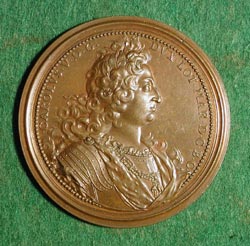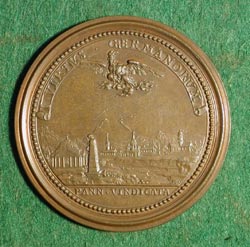

|
CHARLES V OF LORRAINE- EXPULSION OF THE TURKS FROM HUNGARY ST URBAIN, Ferdinand de: Lorraine, ca.1686, Bronze, 58
mm Charles V (Leopold-Nicholas-Sixte) (1643-1690), Duke of
Lorraine and Bar (Barrois), was born in Vienna, the son of Charles IV's
brother Nicolas Francis. In 1678 he married Eleanora Maria, sister of Holy
Roman emperor Leopold I. Emperor Leopold I gave him a regiment with which
he distinguished himself at the battle of Saint Gotthard. He was promoted
field marshal by the emperor in 1675. In 1683, with a weak imperial army,
he opposed the Turkish advance on Vienna. Fortunately, John Sobieski's
Poles and Bavarian and Saxon contingents arrived to reinforce Charles, and
together these Christian forces routed the enemy and raised the siege.
Advancing into Hungary, Charles stormed Neuhausel, took Buda and in 1687
won the great victory of Mohacs, a city situated on the Danube River at
the southern part of Hungary. Besides being a military genius that made
him one of Louis XIV's most respected adversaries, Charles V evidenced
good qualities of statesmanship. However, because of France's opposition,
he never ruled his duchies. At the peace of Ryswick (1697), Lorraine and
Bar were assigned to his son Leopold Joseph Charles, the future Leopold I,
Duke of Lorraine and Bar. LINK to History of Lorraine (from Proceedings of the Friesian School. Edited by Kelley L. Ross, Ph.D.) |
|